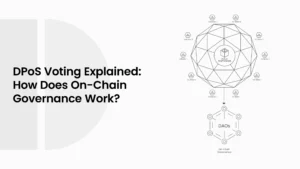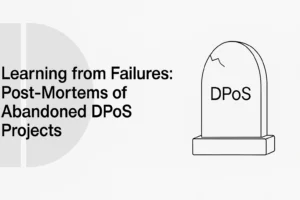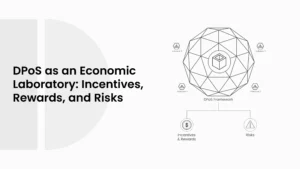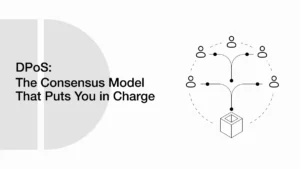Is DPoS the Future of Scalable Governance in Blockchain?
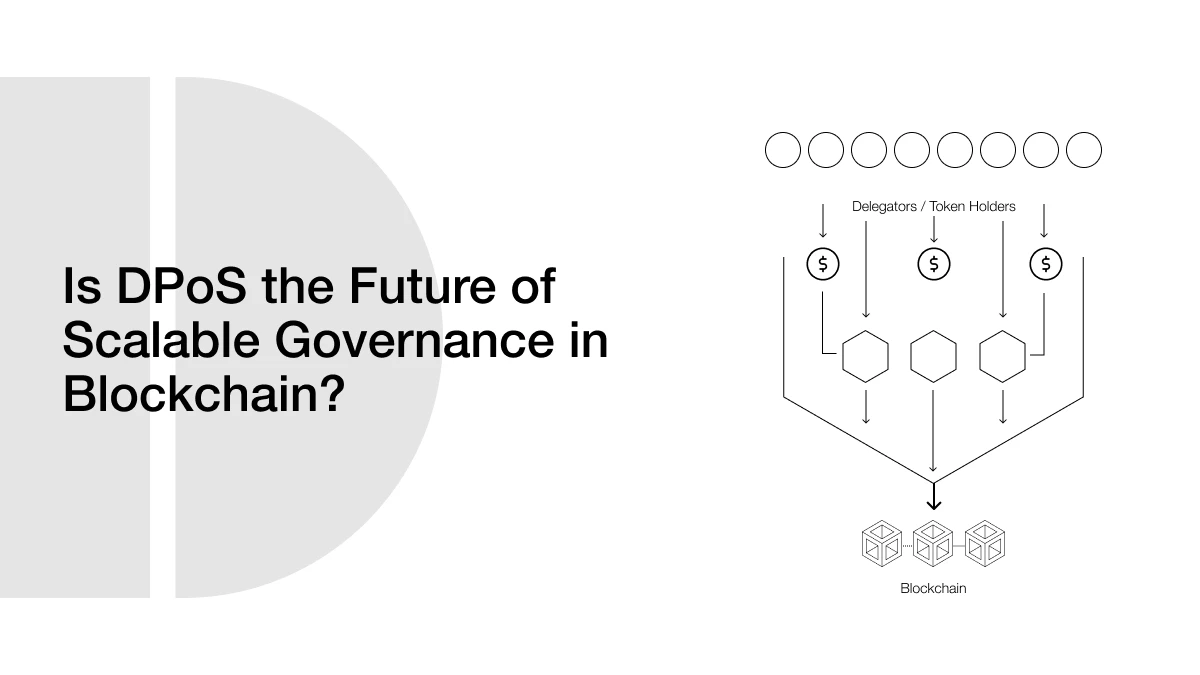
With the advancement of blockchain technology, the demand for networks that are faster, more scalable, and more energy-efficient is growing. Every blockchain includes a consensus mechanism that enables decentralized nodes to reach a consensus on the state of the network. Classic blockchains, such as Bitcoin, utilize Proof of Work (PoW), whereas contemporary ones rely on Proof of Stake. Amid the evolving needs of the industry, a new system has recently emerged, referred to as Delegated Proof of Stake (DPoS).
- What Is a Blockchain Consensus Mechanism?
- How DPoS Works
- How to Delegate Your Vote in a DPoS Blockchain (Step-by-Step)
- Why DPoS Enables Fast Finality Blockchains
- Block Producers in DPoS: Who Are They and What Do They Do?
- EOS vs TRON: A Quick Comparison
- DPoS vs PoW vs PoS: Consensus Algorithm Explained
- Proof of Work (PoW):
- Proof of Stake (PoS):
- Delegated Proof of Stake (DPoS):
- Top 5 Blockchains Using DPoS in 2025
- Is DPoS the Future of Effective Governance?
- The Final Word
- Frequently Asked Questions (FAQs)
- Glossary of Key Terms
DPoS is a consensus mechanism that encourages rapid validation, engaged participation, and effective governance. What features enhance its effectiveness? Could this be the future of effective blockchain and decentralized governance? This blog will detail the workings of DPoS, outline its pros and cons, and emphasize its increasing relevance in the blockchain industry.
What Is a Blockchain Consensus Mechanism?
A blockchain is a worldwide network of computers (known as nodes) that collaborate to maintain a shared record of transactions, similar to a massive digital notepad that everyone can view but cannot change.
But how do all these computers reach a consensus on what should be included in the notebook? That’s the point where a method known as a consensus mechanism comes into play. It’s similar to an electronic voting platform that ensures everyone is aligned, despite the absence of a leader.
Different blockchains use different ways to do this:
- Bitcoin employs the Proof of Work (PoW) consensus mechanism, wherein miners compete to solve complex mathematical problems in order to validate transactions and secure the network. While this method is known for its robustness and security, it is also notably slow and highly energy-intensive.
- In contrast, Ethereum 2.0 and Cardano utilize a Proof-of-Stake (PoS) consensus mechanism. Rather than performing computational tasks, participants in PoS systems stake their cryptocurrency, locking up a certain amount of tokens to gain the right to validate transactions. This approach significantly reduces energy consumption. However, it introduces other challenges, such as the tendency for influence to concentrate among users with larger holdings, thereby raising concerns about wealth-based centralization.
Now, this is where Delegated Proof of Stake (DPoS) emerges as a more refined and efficient alternative. Instead of every node doing the hard work, DPoS allows the community to vote for a few trusted individuals, known as delegates or block producers, to handle transactions and add new blocks. It’s like electing a mini-parliament to run the system efficiently.
This means:
- Less energy is wasted.
- Faster transactions get through.
- And everyone still gets a say, even if they don’t want to get their hands dirty with tech stuff.
As noted in a 2023 study by Krishnan et al., DPoS has been shown to outperform both PoW and traditional PoS models in terms of speed and energy efficiency, particularly for high-throughput networks targeting real-world applications (Krishnan et al., 2023).
Furthermore, this voting mechanism adds a level of governance. As blockchains evolve and strive to perform more complex tasks (such as global apps or real-time payments), DPoS provides a means of maintaining flexibility, scalability, and decentralization. It’s like transforming a chaotic group conversation into a well-organized team effort with moderators chosen by the members.
How DPoS Works
Consider a collaborative environment, such as a group project, where assigning responsibilities to everyone can lead to inefficiencies. Instead, the group chooses to appoint a few reliable individuals—those who are consistent and capable—to manage the core tasks. This analogy closely reflects the operational model of Delegated Proof of Stake (DPoS) in blockchain systems.
Unlike Proof of Work (PoW) or traditional Proof of Stake (PoS), where all network participants are involved in validating transactions, DPoS allows token holders to elect a limited number of trusted representatives, referred to as delegates or block producers, to perform this role on their behalf. In essence, holders signal their confidence by assigning their voting power to these individuals. The weight of each vote is proportional to the number of tokens held, meaning users with a larger stake exert greater influence in the selection process.
Once the votes are in, only the top delegates get selected. These block producers take turns adding new blocks to the chain. For example, EOS picks 21 of them, and TRON uses 27. And no, they don’t get to slack off; each one has a turn, and if they miss it or try something shady, they can get voted out real quick. It’s like being fired from a job because the group found someone better on LinkedIn. This setup keeps things moving fast.
Unlike Bitcoin’s Proof of Work (PoW) mechanism, which can result in lengthy block confirmation times, Delegated Proof of Stake (DPoS) enables block production within seconds. This efficiency is largely due to its reliance on a limited group of elected validators, significantly reducing the computational overhead and energy consumption associated with consensus.
DPoS is often described as a form of liquid democracy, wherein participants have the flexibility to either vote directly for validators or delegate their voting power to individuals they trust to act on their behalf. According to Cointelegraph, this setup enhances performance by keeping the system tight and organized. No more random selection. No more wasting energy. Just smooth block-building by the elected pros.
| Governance Model | Who Votes | Vote Delegation? | Flexibility | Used In Blockchain? |
| Direct Democracy | Everyone | No | Low | Rare (not scalable) |
| Liquid Democracy | Everyone | Yes | High | DPoS-based systems |
| DPoS (Practical Form) | Token Holders | Yes | High | EOS, TRON, etc. |
How to Delegate Your Vote in a DPoS Blockchain (Step-by-Step)
Delegating in a DPoS system is easy, and you don’t even lose your tokens. Here’s how it usually works across most chains:
- Get the Right Wallet
Download a wallet that supports the DPoS network you want to join (e.g., Anchor for EOS, TronLink for TRON).
- Buy or Transfer Tokens
Ensure you hold the network’s native token (such as EOS or TRX).
- Open the Delegation/Stake Section
In your wallet or dashboard, find the “Stake” or “Vote” tab.
- Choose Delegates (Block Producers)
Browse the list of candidates. You can review their performance, uptime, and community contributions.
- Cast Your Vote / Stake Your Tokens
Select your preferred delegates and confirm the transaction.
- Monitor & Re-delegate If Needed
Keep track of how your chosen delegates perform. If they start underperforming, you can switch your vote at any time.
Why DPoS Enables Fast Finality Blockchains
A key benefit of DPoS is quick finality, the rate at which a transaction is validated and deemed irreversible. In conventional PoW networks such as Bitcoin, it may take multiple minutes (or more) for transactions to receive complete confirmation. Even PoS networks, though more efficient, frequently necessitate waiting for several validator confirmations.
ALSO READ: How to Delegate Tokens on a DPoS Blockchain (Step-by-Step Guide)
With DPoS, a small, predetermined group of delegates is established and prepared, allowing blocks to be generated within seconds. There’s no requirement to postpone for arbitrary validator selection or energy-demanding calculations. Every delegate signs blocks sequentially in a specified sequence.
The EOS network can adapt the block every 0.5 seconds, whereas most conventional blockchains have much slower speeds. This speed enables fast finality blockchains, which are essential where delays cannot be tolerated, such as in payments, gaming systems, or tracking shipments.
Block Producers in DPoS: Who Are They and What Do They Do?
| Role | Description | Responsibility |
| Token Holder | Owns and locks tokens | Votes for delegates |
| Delegate / Block Producer | Elected node that validates blocks | Validates transactions, produces blocks, and earns rewards |
| Observer Nodes | Non-elected participants | Track network state and governance proposals |
| Governance System | Smart contracts & voting infrastructure | Enables on‑chain proposals and updates |
In the DPoS system, the primary validators are referred to as block producers. These are not randomly selected, as in PoS, or self-competing miners, as in PoW. Instead, the community selects block producers, which are recognized entities, typically organizations or individuals with technical expertise. Their main responsibilities include verifying transactions, creating and incorporating new blocks, and maintaining network availability and reliability.
In DPoS, block producers are compensated for their work through transaction fees or by generating new tokens. However, their position is never guaranteed. If they lack integrity in their performance or fail to generate blocks, token holders can quickly vote them out.
This structure creates a strong system of accountability. Delegates must maintain technical expertise and community trust. Since their position and earnings depend on votes, producers often run transparency reports and campaigns actively. Still, some critics argue this can lead to centralization, especially if only a few producers dominate the vote share across time.
EOS vs TRON: A Quick Comparison
| Feature | EOS | TRON |
| Block Producers | 21 active + standbys | 27 Super Representatives |
| Reward Structure | Continuous inflation rewards | Voting + block rewards |
| Voting Mechanism | 30 votes per user | 1 vote per TRX (weighted) |
| Governance Model | On-chain referenda | Community proposals |
DPoS vs PoW vs PoS: Consensus Algorithm Explained
| Feature | PoW (Proof of Work) | PoS (Proof of Stake) | DPoS (Delegated PoS) |
| Example Blockchains | Bitcoin | Ethereum 2.0, Cardano | EOS, TRON, WAX |
| Validator Selection | Solve puzzles | Stake-based selection | Elected delegates |
| Energy Consumption | High | Moderate | Very Low |
| Speed/Finality | Slow (10 min+) | Faster (seconds–minutes) | Very Fast (sub‑seconds) |
| Governance Layer | None | Limited | Built‑in voting & proposals |
| Decentralization | Very High | Moderate | Moderate to Low |
| Incentives | Block rewards | Staking rewards | Rewards + community influence |
To understand why DPoS is gaining ground, we need to compare it with its peers.
Proof of Work (PoW):
- Used by Bitcoin
- Highly secure but slow and energy-consuming
- No voting or governance layer
Proof of Stake (PoS):
- Used by Ethereum 2.0, Cardano
- Stakeholders validate based on token holdings
- Faster than PoW, but risks “rich get richer” dynamics
Delegated Proof of Stake (DPoS):
- Used by EOS, TRON, WAX
- Token holders elect a small number of block producers
- Very fast, low-energy, democratic voting layer
- Trade-off: Reduced decentralization vs PoW
DPoS is distinguished by the focus on governance and efficiency. It is freer than PoW, but at the same time, it offers a scalable solution and community involvement. Regarding effective consensus models, DPoS is currently the first in terms of transaction speed and adaptability, especially within Layer 1 chains, which facilitate the use of complex applications and human interactions.
Top 5 Blockchains Using DPoS in 2025
Here’s a quick look at some of the most prominent blockchain networks currently using Delegated Proof of Stake (DPoS) as their consensus mechanism:
| Rank | Blockchain | Year Launched | Use Case Focus | Notable Feature |
| 1 | EOS | 2018 | DeFi, enterprise apps | 21 block producers, 0.5s blocks |
| 2 | TRON | 2018 | Content delivery, Web3 | 27 block producers, high speed |
| 3 | WAX | 2019 | NFT marketplaces, gaming | Carbon-neutral, gaming-focused |
| 4 | Steem | 2016 | Blockchain social media | Reward-based voting |
| 5 | BitShares | 2015 | Asset exchanges | First DPoS chain, high throughput |
Is DPoS the Future of Effective Governance?
None of the consensus methods is ideal. The Delegated Proof of Stake (DPoS) can be an attractive choice for scalable blockchain governance. Its main strengths include improved energy consumption levels, quicker transaction speed, and the implementation of democratic rule within the community. These features can make DPoS-based networks not only efficient and sustainable, but they can also be applied in industries with strict performance demands and fast response times, such as decentralized finance (DeFi), gaming, and logistics.
| Feature | Strength | Potential Concern |
| Speed | Sub‑second block times | Centralization risk |
| Governance | Community voting for producers | Voter apathy or manipulation |
| Energy Efficiency | Low resource consumption | May sacrifice decentralization |
| Accountability | Easy to replace underperforming delegates | Risk of cartel formation |
The limited validator system is a crucial component that contributes to the efficacy of DPoS. Instead of relying on thousands of competing or randomly selected nodes, DPoS limits validation to a predetermined group of elected block producers. This strategy significantly decreases the complexity and energy required for the consensus process. As a result, DPoS chains can provide comparable throughput and dependability to traditional cloud systems while also incorporating decentralized voting and community accountability through delegate voting mechanisms.
These advantages, however, are not without drawbacks. As mentioned in the International Journal of Informatics and Computing, the long-term viability of DPoS will be determined by how effectively these vulnerabilities are managed by both technical and governance advances (IJIC, 2024).
The Final Word
To support billions of users while maintaining reliability and efficiency, blockchains must evolve from financial instruments to global networks. DPoS is a big step in the right direction.
It evolves swiftly, encouraging involvement and oversight, and providing a feasible alternative when traditional PoW or PoS systems face challenges. DPoS demonstrates how delegated voting, fast validation, and strong governance can be integrated into a single, scalable system, despite the existence of other consensus techniques for blockchains.
When properly designed and implemented, DPoS can truly represent the future of blockchain governance by combining scalability and decentralization.
Frequently Asked Questions (FAQs)
- What is a consensus mechanism?
It’s the method blockchains use to get all the computers (nodes) to agree on the same version of data. Think of it as a voting system that keeps everything honest and synced, even without a boss in charge.
- How is DPoS different from PoW and PoS?
In Proof of Work (PoW), miners solve hard puzzles. In Proof of Stake (PoS), validators are chosen based on the number of tokens they hold. But in Delegated Proof of Stake (DPoS), people vote for a few trusted validators (called block producers) to do the heavy lifting. It’s like choosing class reps to speak for the whole class.
- Do I lose my tokens when I vote or delegate?
Nope! Your tokens stay in your wallet. You’re just giving someone else the power to validate blocks on your behalf.
- How many block producers are there in DPoS?
It depends on the network. EOS has 21 active block producers, and TRON has 27. Each takes turns producing blocks, like a rota system.
Glossary of Key Terms
Blockchain
A digital, decentralized ledger that records transactions across multiple computers.
Node
A computer that’s part of a blockchain network. Nodes store, validate, and share data.
Consensus Mechanism
The process used by a blockchain to get all nodes to agree on the same state of the network.
Proof of Work (PoW)
A system where computers solve complex math problems to validate transactions. It’s secure but energy-heavy.
Proof of Stake (PoS)
A system where users stake coins to be randomly chosen as validators. The more you stake, the more likely you are to be picked.
Delegated Proof of Stake (DPoS)
A version of PoS where token holders vote to choose a few validators (block producers) who confirm transactions and run the network.
Token Holder
Someone who owns cryptocurrency tokens. In DPoS, token holders vote for delegates.
Delegate / Block Producer
An elected participant in a DPoS blockchain responsible for validating transactions and producing blocks.
Staking
Locking up your tokens in the network to help secure it and possibly earn rewards.
Voting Power
The influence a user has when voting in DPoS. More tokens = more voting weight.

